Alison Roth Cooley
In the summer of 2012, at the Tate modern, I line up to see Damien Hirst’s major retrospective with my mother. The line is so long we won’t be able to get in for several hours. People want to see Damien Hirst. I want to see Damien Hirst. I have always suspected that I hate him, hate his work. When I tell my colleague, an ally in vegetarian feminism, that I feel compelled to see the Hirst show, she suggests it’s never acceptable to use a dead animal to make art. Art’s ethical imperative is not to hurt.
For the past few years, I have been reading animal studies criticism, a discourse that look at the role of non-human animals as symbols in human culture. Animal studies theorists like Steve Baker seem less sure what art’s ethical imperatives are when it comes to animals. Animal studies theorists in general seem unsure about ethics. Shy. I wonder if they feel so invested in legitimizing discourse about animals, opening it to people who would otherwise see animals as unimportant, that they intentionally avoid questions of animal rights and animal welfare in their research.
I want to look at animal bodies, and so I want to see Hirst.
More than that, I want to look at hybrid bodies: places where humans and animals, at the level of genes, at the level of their tiny constituent parts, become indistinct. Hybrid human-animal figures populate ancient mythologies, the well-trod ground of surrealism, and kitschy craft and design (animals become anthropomorphic figurines, some Canadian nostalgia for wilderness embodied in the figure of a plaid-clad child with antlers). They resurface in contemporary art, from David Altmejd’s grotesque sculptural mutations of natural history, to Patricia Piccinini’s 2002 hyper-realistic human-dog sculpture, renowned internet-wide as a hoax, purported by some spiteful message board poster to be an image of a successful human/dog cloning experiment in China, and taking off thereafter into an internet abyss.[1]
Our relationship with hybrid bodies in contemporary culture easily conjures up questions of science, genetics, and cloning. The language of display for science and medicine is one we’re familiar with: from the looming taxidermy-lined halls of natural history museums to the dissection of fetal pigs in biology classrooms to the iconic spiraling double helix (somehow always a mental image in computer-generated 3-D, garish colours and rotating slowly). We understand the visual place of these constructs, even when we don’t remember what genes are made of or which organs fit together in the bodies of perfect specimens.
As cultural producers, arts workers, and academics, we can be excited and intrigued by interdisciplinarity. The nuances of science and technology can be sites of wonder for artists and writers and those of us who believe we live on the culture side of an old and enforced binary. We study engagements between art and science. We often struggle to get the technical details of the working of the world correct, we are bound to them in fascination.
Did I go see Damien Hirst’s retrospective because science is exciting?
Increasingly, public perceptions of biological and genetic sciences prompt scandal. Cloning and genetic modification spin apocalyptic scenarios in Margaret Atwood’s Maddaddam trilogy. Alongside Hirst, the work of fellow Young British Artists Jake and Dinos Chapman provokes cultural discomfort to drive the art market, boys and girls with extra heads and misplaced genitals, the ubiquity of of genetic anxiety.
Am I compelled by good science to look at these works?
Morbid curiosity. The first time we visit the Tate, we see the line-up in the turbine hall, and we see Yayoi Kusama instead of Damien Hirst.
Morbid curiosity consumes. The second time we go to the Tate, we’ve planned ahead, purchased tickets online. I always knew I was going to see something questionable. Now I know I’m making an incredible effort to see the questionable thing. Morbid desire. Morbid lust for the flesh of dead animals. Steve Baker makes the distinction between animal-endorsing and animal-sceptical artwork: work which makes the animal heroic or symbolic, or work that asks about human relationships to animals.[2] Despite my discomfort, I’d tend to categorize Hirst as animal-critical. His work looks at animals as objects, as visual phenomena- questions what they mean, if they mean the same for all of us.
When Hirst began working with formaldehyde in 1991, he produced what are now known as his ‘Natural History’ works: two fish in Isolated Elements Swimming in the Same Direction for the Purpose of Understanding, cases filled with jars of formaldehyde and cow’s organs in The Lovers, the iconic shark The Physical Impossibility of Death in the Mind of Someone Living, and the bare cases of formaldehyde, Stimulants (and the Way they Affect the Mind and Body).
The shark work is famously and none-too-subtly about death. His work is famously about death. His work is famously about wealth. This is old news. Damien Hirst is an easy target for criticism. So easy a target that reviewers were unanimously underwhelmed (some even insulted) by the show.[3] And yet the show set a new visitor attendance record for any solo exhibition ever at the Tate.[4] I am not lonely in my equivocal compulsion to see Hirst’s works in the flesh. To see the flesh of Damien Hirst’s work.
If I endorse Damien Hirst, I doubt I am being animal-critical. I am simply being Hirst-endorsing. Is it possible I am endorsing him simply by being there? My tourist dollars to the Tate twice. Hirst is an easy target, but as an emerging writer I’ve been cautioned against speaking ill of an artist or gallery I might someday want something from. We practice criticism by omission, check our LinkedIn profiles ambitiously.
Julian Spalding calls Hirst a con artist.[5] It’s a well-established position, but not one I am interested in. It seems like a slippery slope that leads to an undervaluation of artists’ labour if they don’t produce work to a given critic’s taste.
No, Hirst’s work is seriously engaged with animal bodies, with natural history, with the vague and serious territory of death. But does it, despite all the glass and formaldehyde, say anything about science? Or animals? In an easy symbolic gesture, Hirst’s animal bodies appeal to our humanity.
My mother, a ceramics artist and craftsperson, suggests that she never knew how much Damien Hirst’s work was about collecting. As if being about collecting is redemptive.
Damien Hirst provokes the most disgusting kind of animal ethical relativism in me. If people kill to eat every day, if they raise animals in deplorable conditions, if industrial farmers select for frightened meat drones for aesthetic and gustatory delight, why not mount a specimen as art? When I consume Damien Hirst, am I eating an animal’s flesh?
I leave the Tate. There are four crochet banners in the window. “We can’t compete/We won’t compete/We can’t keep up/We won’t keep down.”
My previous inability to take a stance on Hirst seems weak and ugly.
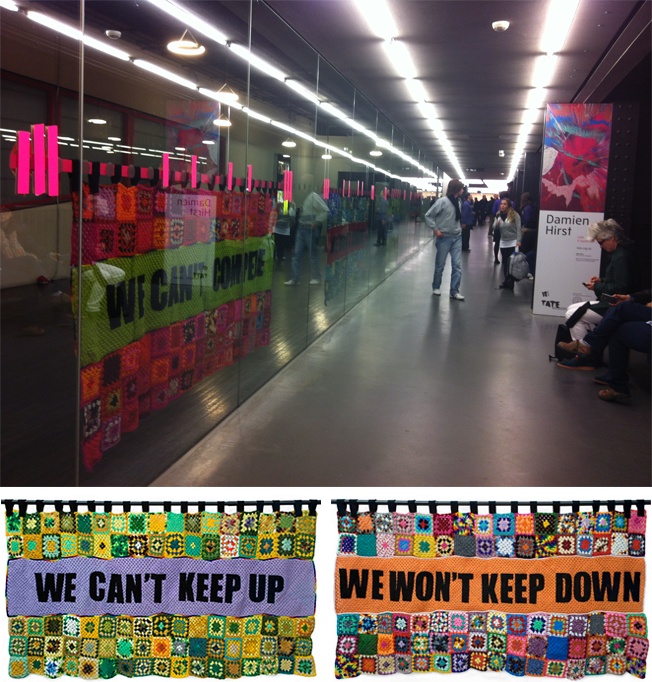
Feminist Art Gallery, CAN’T/WON’T, 2012, crochet banner. Image courtesy of Allyson Mitchell. Photo credit Michele Clarke.
FAG at the Tate. An insistence on queer and feminist politics and desire in the gallery. A big crocheted disavowal of Hirst and the conditions commercial art world success seems to come with.
Allyson Mitchell and Dierdre Logue, who host the Feminist Art Gallery in their backyard, first hung the pieces with duct tape, only to be informed that wasn’t appropriate for the Tate. A dead shark, a crystal skull, the resonant surfaces of crochet and duct tape.
I see the banners later, at the University Art Association Conference at Concordia University in the fall of 2012. The slick shifting contexts of these works is amazing. Dyke march. Damien Hirst. Academy. An emerging scholar notes she feels helpless and invigorated by the work, the state of funding in the institution for the vague territories outside the hard sciences. At Concordia, a student remarks on their resonance with the student strike, the red crocheted square she wore on her chest because it was more comfortable than craft store felt, the day they brought their dildos to class in protest.
We look at Damien Hirst, working within the language of science, replicating natural history display and inserting cheeky titles about the inevitability of death. Perhaps in the same way, we look closely at the entire discipline of bioart. We examine these things in morbid curiosity because we think they present critical engagements with science. And we forget that to sometimes to engage with science and with the critical territory it provokes, it is not enough to simply replicate scientific modes of working. What if we looked at Mitchell instead, the hairy kitsch of hybrid queer feminist fat human animals? This work could tell us more about science and sex and why we fear and find fascination in them.
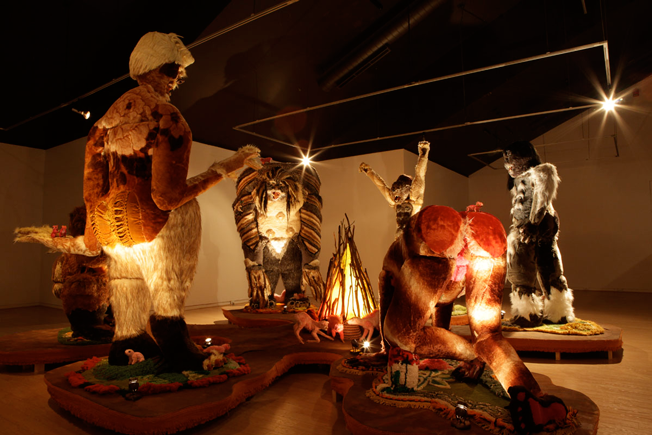
Allyson Mitchell, Ladies Sasquatch, 2005-2009, mixed media installation. Image courtesy of Allyson Mitchell.
Mitchell’s installation, Ladies Sasquatch (2005-2009), consists of six lesbian monsters and their tiny familiars, gathered around a small campfire. Borrowing from colonial appropriations of First Nations Sasquatch mythology, Mitchell’s figures are beastly and huge, made from fun-fur, found, discarded, and vintage textiles. These hairy, fat, and sexually-expressive figures have soft and luxurious textures, and their gestures and expression oscillate between fierce and enticing. In Ladies Sasquatch, Mitchell pictures women’s sexuality as monstrous, monumental, and uncompromising. She writes, ‘Lady Sasquatch is your dream girl, only bigger and hairier,’ designed to push back against so-called common-sense values of women as hairless, small, white, and visible expressly for the pleasure of the heterosexual man.[6] This decisive queer feminist sensibility echoes throughout Mitchell’s Deep Lez I Statement, published in the show catalogue and posted alongside the work, and emblematic of Mitchell’s self-identification as a ‘maximalist feminist artist.’[7] Mitchell describes her practice as using ‘maximum materials, maximum emotion, maximum politics, and maximum space,’[8] and this self-identification as a maximalist and as a political artist demands a discussion of her work on these terms. But the Sasquatches are not without nuance. They also respond cleverly to the nature-culture binary, asking what it could look like for gender and sexuality to dwell outside of the confines of culture.

Allyson Mitchell, Brainchild, 2008, mixed media installation. Image courtesy of Allyson Mitchell.
The thematic of unapologetic campy human animals permeates much of the rest of her work as well. In the 2004 exhibition, The Fluff Stands Alone, Mitchell creates tapestries and bedspreads of fat, hairy, sexualized, women, full of kitsch and glamour, playboy poses painstakingly recreated, the figures not yet monstrous, but strange and cartoonish as much as celebratory. In the 2006 Series, the Humanimals, Mitchell pastes together the bodies and faces of porcelain figures, giving human faces to dogs and cats. In a later series entitled Brainchild (2008), she imagines that big-bonnetted Holly Hobbie and Precious Moments dolls are secretly housing immense and more-than human brains, lined up to worship at the base of a giant textile master-brain.
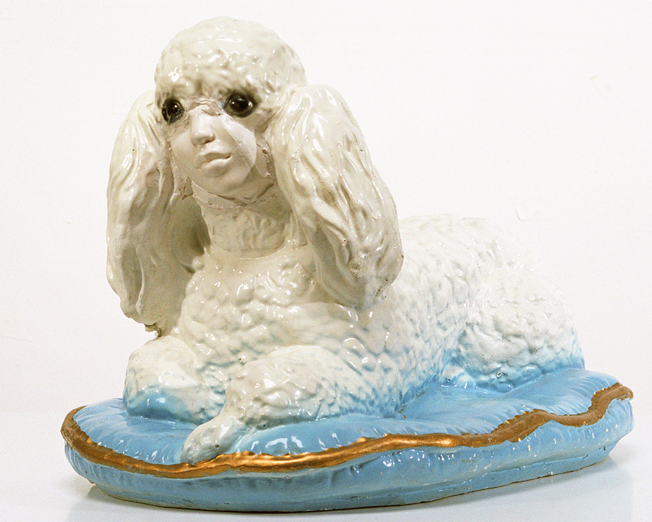
Allyson Mitchell, Poodley Poo, 2006, ceramic and glass eyes. Image courtesy of Allyson Mitchell.
Mitchell is not a counterpoint to Hirst because she does what he wants to do, only better. She is a counterpoint because her work carries none of the same language of science, but anchors nature and culture unabashedly in the same territory.
Other artists like Patricia Piccinini have made it their business to look at hybridity, sexuality, and science, mimicking and playing with the language of natural history, genetics and truth. Hers is interesting work, championed even by eco-feminist scholars such as Donna Haraway and proof that critical engagements with science can happen using its own language. Piccinini’s work provokes in me a similar naïve fascination with science and genetics, with none of the hangover of Hirst’s. Meanwhile, Mitchell’s suggests an entirely alternate methodology, grounded in kitsch, camp, and queer feminist insistence on politics.
Hybridity in Mitchell’s artwork is exemplary of what Animal Studies theorist Steve Baker calls ‘botched taxidermy.’ He coins this term not to refer uniquely to taxidermy in artwork, but ‘to characterize those instances of recent art practice where things appear to have gone wrong with the animal… but where it still holds together.’[9] Mitchell’s sculptures have indeed gone wrong. The broken faces and mashed-together bodies of the Humanimals are certainly troubling. But, both the white ceramic surfaces and the spray-painted bodies and faces maintain a familiar innocence, of novice paint-at-home figurines, collectibles, and non-threatening objects intended for domestic display. The composed and serene gestures of the animal figurines contrast harshly with their unexpected, disjointed, and even contorted faces.
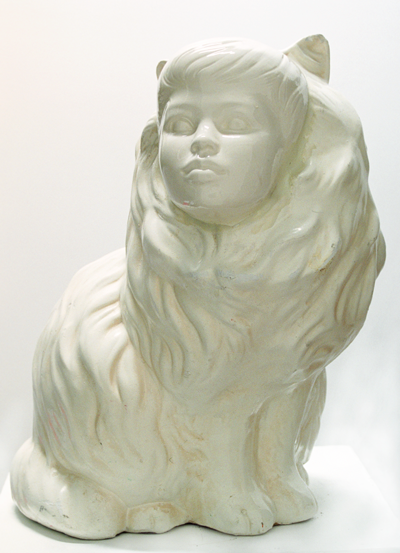
Allyson Mitchell, Puss Puss, 2006, ceramic. Image courtesy of Allyson Mitchell.
Can a human figure be botched taxidermy? The disturbing cuteness and newfound cognitive capacity of the figures in Brainchild, their bonnets seeming to swell with Mitchell’s exaggerated pasting-in of fuller brains?
One of Baker’s key examples of botched taxidermy is Hirst’s shark, the older, wrinkled one, which he eventually replaced. It is tatty and pathetic: a more strange than threatening figure, despite Hirst’s impressive intentions.[10]
The language of Botched Taxidermy and the Postmodern animal parallels Freud’s notion of the uncanny as well.[11] Baker suggests that ‘the look of the postmodern animal, no surprises here, seems more likely to be that of a fractured, awkward, “wrong,” or wronged thing, which is hard not to read as a means of addressing what it means to be human now.’[12] The question of humanity and human systems of thought, categorization, and identification run throughout the work. Mitchell’s uncanny creatures are fragmented. They express an essential duality (of human and animal), and they signal the invasion of the home and the domestic by the strange and awful, expressing a degree of uncertainty about the proper place for the human and animal body. As Freud suggests, the uncanny hints at the return or confirmation of primitive beliefs,[13] in this case a reiteration of the closeness (genetic and lived) of humans and animals. From the tension between the animate and inanimate to the question of the imaginary, the return of the mythic, and the concept of species separateness, the boundary between human and animal becomes the site for the uncanny transgression, the possibility of the unsettling recognition of ourselves in a familiar (or invasive) figure.
It isn’t just taxidermy that provokes these sensations, some taxidermist, folding skin over muscles and bone, an erotics of morbid animality, Hirst’s fascination with dead animals telling us something about living humans. In Mitchell’s work, it can be the crafter, the lesbian, the activist, who looks to the perceived naturalness of human behaviour and identity.
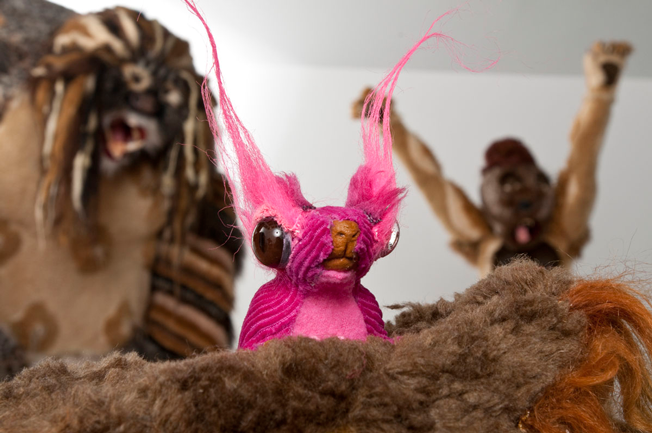
Allyson Mitchell, Ladies Sasquatch (detail), 2005-2009, mixed media installation. Image courtesy of Allyson Mitchell.
Or perhaps it is about monstrosity. This morbid fascination with Hirst, is it that we might see a monster, some sideways glimpse of a dead animal or a dying one, a view of human nature as truthfully ugly? Something sublime in the butterflies arranged like church windows, the cases of pills like altars? And if we do see something monstrous, what has Hirst provoked in us?
Just as Freud insists that uncanny forms unsettle by reminding us of our primitiveness, Jack Halberstam similarly suggests, in their writing on the monster, that it ‘always represents the disruption of categories, the destruction of boundaries, and the presence of impurities and so we need monsters and we need to recognize and celebrate our own monstrosities.’[14] Mitchell’s Sasquatches fit squarely into the category of ‘feminist monster ethic,’[15] troubling the boundaries between human and animal, representing desirability outside normativity. Both Ladies Sasquatch and Mitchell’s quieter monsters, the Humanimals and Brainchild, are reminders of the insidiousness of this divide and its mediation of our routine interactions with other living things in the world.
In a tangled discussion of nature and culture, love and companionship, Donna Haraway coins the term ‘naturecultures’ to refer to the inseparability of the two concepts: nature always defined through a the cultural values of the moment, culture bleeding into every human interaction with even the most purportedly pristine wilderness. Borrowing from Lynn Margulis’ concept of symbiogenesis, the merging of two organisms to form a new ones , Haraway articulates the intense level of genetic similarity between humans and their companion species.[16] Companion species are not merely animals with whom we share space, she suggests, but animals with whom significant bonds of love and companionship manifest down to the cellular level.
Just as Haraway deliberately provokes, suggesting in her companion species manifesto that she and her dog have ‘had forbidden conversation; we have had oral intercourse; we are bound in telling story upon story with nothing but the facts,’ that ‘we make each other up, in the flesh,’ so Mitchell envisions a relationship between human and animal that is precariously constituted in the flesh. Mitchell quite literally visualizes the human and the domesticated animal, as making up each other, in the flesh. Positioning the two in the same physical space, she forcibly melds them, rendering unclear whether this form is an iteration of love or monstrosity. The sexually provocative tone of ‘oral intercourse,’ and ‘making each other up in the flesh,’ echoes.
Animals are stand-ins for sex acts we feel squirrelly or sheepish about. Puns. Pussies, beavers, bitches, bears, cocks, fish, the mundane similes of the Bloodhound gang, the almost elegant ‘beast with two backs,’ the refrain that a woman is treated like a piece of meat.[17] When we use these words, we suggest the very act of sex is a capitulation to our animalistic nature.
Catriona Mortimer Sandilands and Bruce Erickson, in Queer Ecologies, suggest that alongside nature/culture binaries, there exist a set of binaries which de-legitimize queer sexualities. The nature/culture binary can be used to suggest queer sexualities as ‘unnatural’ from an evolutionary standpoint and so to discredit queer sexualities, positioning them as ‘the perverse, the polluted and the degenerate against the fit, the healthy, and the natural.’[18] Central to this argument is the question of reproductive sexuality. Mortimer-Sandilands and Erickson coin the term ‘repro-centric discourses,’ to suggest the centrality of reproductive sex to our concept of the natural.[19] By suggesting queer sexuality is unnatural, such discourses seek to de-legitimize queer identities.
This discourse of unnatural sexuality lumps together multiple kinds of sexual behaviour, equating queerness with any number of sexual taboos and so-called deviant behaviours. In Mitchell’s work, the sexual transgression of the species boundary manifests in the form of the human-animal hybrid. Mitchell borrows this strategic equation in her work, pushing it in her hybrid works to suggest a kind of thematic alliance with all those whose sexualities are marginalized by discourses of naturalness. By inhabiting the borderline of nature/culture, Mitchell’s monstrous figures question the very concept of the natural by proxy.
For Gender Studies scholar Geeta Patel, the queer body is a hybrid body. Resisting the slide into established normative gender and sexuality, queer bodies and identities ‘put the seeming uniformity of heterosexuality to the test.’[20] Under the productive and multiplicitous umbrella of queer, hybridity presents a chance for the melding of identities, of genders, and of bodies. Mitchell also queers her sculptures by confounding masculine or feminine. While the Ladies Sasquatch and the figures in Brainchild are unmistakably feminine, the Humanimals seem decidedly neither. The original human figures from which Mitchell borrows faces probably read as either male or female, but divorced from their original context and recombined, they read as neither. So too is sex as a natural boundary both violated and erased within the work. While Mitchell’s Humanimals are boundary-transgressors and question the separation of nature and cultural, human and animal, natural and unnatural behaviour, they are also an embodiment of the threat of impossibly reproductive (and thereby often so-called deviant) sex. As a way of imagining the physical results of a human-animal (and a human-companion-species) sexual encounter, Mitchell’s Humanimals present a deliberate violation of the so-called natural order.
Current genetic research suggests, however, that human-animal hybrids are not as impossible as once believed – not by reproduction, but by replication; a cyborg strategy. Cloning practices for human-animal hybrids currently exist in highly-regulated research environments.[21] Public opinion research clearly demonstrates that the creation of these organisms is highly controversial, with objections ranging from scientific uncertainty to moral authority[22] and disruption of the natural order.[23] A number of scholars identify[24] what they call the ‘yuck’ factor with regard to the creation of human-animal hybrids, which governs a visceral negative response to the idea of species mixing, and has a significant impact on policy making.[25] In much of Mitchell’s work, the language of the uncanny, of botched taxidermy, and of the ‘yuck’ factor appear to collide.
The human-animal hybrid form exemplifies this notion: the familiar animal (and the familiar human, by extension) gone wrong, either by reproduction or by genetics. The form embodies our fear of the divide between human and animal, nature and culture, natural and unnatural, and throws human and animal identity into question. Mitchell chooses this threat in her work, pairing it with kitsch, familiarity, humour, and the domestic, suggesting love, tenderness, and bonding alongside these deeper anxieties. Mitchell embraces the form as a way to address significant binaries and cultural anxieties, the monster as an other proves a useful ally for radical queer and feminist thought.
And while Mitchell’s monsters are provocative and even threatening, I feel at once fascinated an at home with them. I recognize in them, something of my own awkward hybridity.
Before leaving London, I visit the Natural History Museum, I look at Animals Inside Out. I think of Hirst’s animals outside out. Human taxidermy has been taboo for so long. The display of human remains now prompts huge controversy. Repatriation of indigenous peoples’ remains which were stolen or ill-acquired somehow remains contentious. Yet Gunther Von Hagens’ Body Worlds– donated corpses posed for museum pleasure, inexplicably precedes the less successful (perhaps less shocking?) Animals Inside Out.
I find myself a fascinated vegetarian feminist reeling. I’m propelled by my desire- a fascination with Darwin in marble at the end of the great hall of the Natural History Museum, a lust to see the things that are never acceptable for display in any outside context, a morbid curiosity for the testing ground the museum makes in me.
I still feel compelled to see work I know is a lazy engagement with science and ethics, a pitch for money and stardom. But if I am going to gnaw on the shady morality of shock and transgression, at least I can suggest a tangent of alternatives.
I can’t keep up.
Can’t keep up. Won’t keep down.
[1] Radford, Benjamin. ‘The Human Dog Hybrid Hoax.’ Live Science, 18 August, 2009. Web. 20 March, 2013.
[2] Baker, Steve. The Postmodern Animal. (Reaktion Books: 2000), 9.
[3] Stoilas, Helen, ‘Thumbs Down (bar one) for Damien Hirst at the Tate Modern,’ The Art Newspaper, 4 April 2012. Web. 29 September 2013.
[4] Masters, Tim, ‘Damien Hirst helps Tate break visitor record,’ BBC News Entertainment Arts, 19 September 2013. Web. 29 September 2013.
[5] Spalding, Julian, ‘Damien Hirsts are the sub-prime of the art world,’ The Independent, 27 March 2012. Web. 29 September 2013.
[6] Mitchell, Allyson, “Allyson Mitchell: Ladies Sasquatch” (Panel text). Allyson Mitchell. Web. 20 March 2013.
[7] Mitchell, Allyson. “About.” Allyson Mitchell. Web. 20 March 2013.
[8] Mitchell, Allyson quoted in Hof, Jeremy and Allyson Mitchell. ‘Lady Maximus: Allyson Mitchell.’ Border Crossings. No. 111, 2009, 23.
[11] For Baker, like Freud, there is a rough list of strangenesses, which serve as visual categorical markers of this wrong thing. They include mixed materials, stuffed animal toys made strange, hybrid forms, messy confrontations between human and animal, taxidermic form reworked, and tattiness. (Ibid., 56-60)
[13] Freud, Sigmund. ‘The Uncanny,’ The Standard Edition of the Complete Psychological Works of Sigmund Freud, Volume XVII (1917-1919): An Infantile Neurosis and Other Works, 217-256. Web. 26 June 2012. pp. 17.
[14] Halberstam, J. Skin Shows: Gothic Horror and the Technology of Monsters. (Durham and London: Duke University Press, 1995), 24.
[15] Narduzzi, Dilia. “(Un)natural Bodies: Reproduction, Disability, Queerness.” ETD Collection for McMaster University, 2011, 181.
[16] Haraway, Donna, When Species Meet. (Minneapolis: University of Minnesota Press, 2008), 15.
[17] Carol J. Adams’s The Sexual Politics of Meat contains and difficult chapter on this phrase, and the problematics of its use by feminists. Adams, Carol J, The Sexual Politics of Meat: A Feminist-Vegetarian Critical Theory. (Bloomsbury Academic 20th Anniversary Edition, 2010), 64-91.
[18] Mortimer-Sandilands, Catriona, and Bruce Erickson, eds. Queer Ecologies: Sex, Nature, Politics, Desire. (Indiana University Press, 2010), 3.
[20] Patel, Geta. ‘Home, Homo, Hybrid,’ College Literature. 24:1, 2013, 134.
[21] Note that “hybrid” in its scientific sense denotes the blending of the genome of two species, a natural example being the mule. This technology can create animals with human organs or tissue for use in transplant, or potentially produce human embryonic stem cells. Another hybrid category, the scientific human-animal “chimera”, requires grafting cells from one entity onto another, resulting in an entity with discrete parts and populations of cells. This research is also particularly promising as a source of transplant organs. While both technologies currently exist in a research and academic capacity, they necessarily come under strict guidelines (for example, that these organisms not be allowed to pass the fetal stage), in order to prevent harm to humans, research animals, and the creation of new diseases (as in the humanization of animal pathogens such as SARS), among other concerns. See Ballard, Rebecca, “Animal/Human Hybrids and Chimeras: What are They? Why are They Being Created? And What Attempts Have Been Made to Regulate Them?” Journal of Medicine and Law, 2008, and see also Bordet, Sylvie, Sabrina Feldman, and Bartha Maria Knoppers. “Legal Aspects of Human-Animal Combinations in Canada.” McGill Health Law Publication. Vol 1.1, 2007, 94.
[22] Priest, Susanna Horning, “The Public Opinion Climate for Gene Technologies in Canada and the United States: Competing Voices, Contrasting Frames,” Public Understanding of Science, 2006, 63.
[23] Foster, Charles, “Animal-Human Hybrids: Do Theology or Philosophy Help?” Christian Law Review, 2008, 7.
[24] Robert, J.S. and F. Baylis, “Crossing Species Boundaries.” American journal of Bioethics. 3.3, 2003. See also Foster.
[25] Ogbogu, Ubaka, Timothy Caulfield, and Shane Green. “From Human Embryos to Interspecies Creations: Ethical and Legal Uncertainties Surrounding the Creation of Cytoplasmic Hybrids for Research,” Medical Law International, 9, 2008.
Alison Cooley is an emerging arts writer and curator. Originally based in Saskatoon, Saskatchewan, but currently living and working in Toronto, Alison recently completed her MA in Art History at York University with a diploma in Curatorial Practice. Her work examines contemporary Canadian art and craft, animal studies, queer and feminist cultural production, artists working within social justice frameworks, and art criticism.